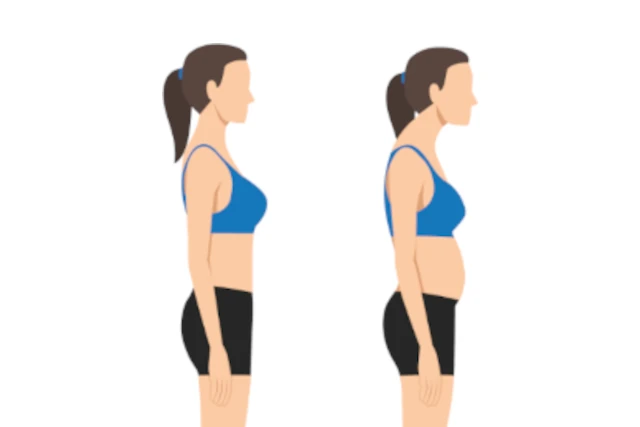
Types of Poor Posture, How to Identify Them, and Effective Ways to Correct Them
- Dr. Nitika Sharma (MPT)
Connect with our expert physiotherapist for personalized physiotherapy advice.
Good posture is crucial for maintaining a healthy body, reducing pain, and preventing future injuries. However, with the prevalence of desk jobs, digital device usage, and inactive lifestyles, poor posture is more common than ever. In this guide, we’ll explore the different types of poor posture, simple ways to identify each type, and practical exercises to help you correct them for better alignment and comfort.
Why Is Good Posture Important?
Good posture is more than just looking confident; it’s a key factor in avoiding muscle strain, joint pain, and tension. When your body is aligned correctly, you reduce the risk of developing chronic issues, especially in the neck, shoulders, and lower back. Proper posture helps optimize breathing, digestion, and blood flow, making it essential for overall health.
Types of Poor Posture
Here are the most common types of poor posture, each with unique characteristics and contributing factors:
- Forward Head Posture (Text Neck)
- Description:
Forward head posture, often called text neck, occurs when the head juts forward from the shoulders. This posture is often seen in people who spend long hours looking down at devices or working at desks.
- Effects:
Puts excessive strain on the neck and upper back muscles, leading to pain, headaches, and tension.
- Identification:
Stand sideways in front of a mirror. If your ears are positioned ahead of your shoulders, you may have forward head posture.
- Correction:
Try chin tucks by pulling your chin back toward your neck without tilting your head up or down. Aim to hold this for 5-10 seconds, repeating several times daily to strengthen neck muscles.
- Description:
- Rounded Shoulders
- Description:
Rounded shoulders occur when the shoulders roll forward, often due to weak upper back muscles and tight chest muscles. This posture is common among people who sit at desks or use computers for extended periods.
- Effects:
Leads to shoulder, neck, and upper back discomfort, and can reduce lung capacity over time.
- Identification:
Stand naturally and let your arms hang at your sides. If your thumbs face each other or toward your body, your shoulders are likely rounded.
- Correction:
Perform shoulder blade squeezes by pulling your shoulder blades together and holding for 5 seconds. Stretching the chest with doorway stretches also helps improve alignment.
- Description:
- Kyphosis (Hunchback)
- Description:
Kyphosis, or a hunchback posture, is an exaggerated forward rounding of the upper back. This can develop from prolonged poor posture or due to weak back muscles.
- Effects:
Causes upper back pain, fatigue, and tension in the neck.
- Identification:
Ask someone to take a side profile photo. If there’s a noticeable curve in the upper back, it may indicate kyphosis.
- Correction:
Exercises like thoracic extensions on a foam roller help reduce kyphosis by strengthening back muscles and improving spine mobility.
- Description:
- Swayback (Excessive Lordosis)
- Description:
Swayback is characterized by an exaggerated curve in the lower back, often caused by weak abdominal muscles and a sedentary lifestyle. It results in the pelvis tilting forward and the chest leaning backward.
- Effects:
Leads to lower back pain, poor balance, and strain on the lower spine.
- Identification:
Stand sideways and check if your hips are tilted forward with a pronounced lower back arch.
- Correction:
Strengthen the core muscles with planks and glute bridges, and stretch the hip flexors to bring the pelvis back into alignment.
- Description:
- Flat Back
- Description:
Flat back posture lacks the natural curves of the spine, making the back appear straight and stiff. It often results from muscle imbalances or prolonged sitting.
- Effects:
Can cause pain, especially in the lower back, and make standing for long periods uncomfortable.
- Identification:
Stand against a wall; if there’s little to no curve in your lower back, you may have a flat back posture.
- Correction:
Strengthen the back extensors and glutes with exercises like hip thrusts and back extensions, and stretch the hamstrings to prevent excessive pulling on the spine.
- Description:
How to Check Your Posture at Home
Regular posture checks can help you stay mindful of your alignment and prevent poor habits. Here are a few simple tests to assess your posture at home:
- Wall Test:
Stand with your back against a wall. Check if your head, shoulders, and hips align with minimal gaps at the lower back and neck.
- Mirror Test:
Stand sideways in front of a mirror and observe if your ears, shoulders, hips, and ankles form a straight line.
- Photo Analysis:
Ask someone to take photos of you from the front, side, and back. Check for any imbalances in alignment, like one shoulder higher than the other or a noticeable curve in the spine.
Tips for Correcting Poor Posture
Consistency is key to improving your posture. Incorporate these daily habits and exercises to support a healthy, aligned body:
- Strengthen Core Muscles:
A strong core supports the spine and reduces strain on the lower back. Exercises like planks, side planks, and dead bugs are effective for core stability.
- Stretch Regularly:
Stretch tight muscles that contribute to poor posture, including the chest, hip flexors, and hamstrings.
- Adjust Your Workspace:
Ensure your computer screen is at eye level and your chair supports your lower back. Avoid hunching over or slumping at your desk.
- Be Mindful:
Practice self-checks throughout the day to stay aware of your posture, especially during prolonged sitting or standing.
- Take Breaks:
Every 30-60 minutes, take a quick break to stand, stretch, and reset your posture.
Conclusion: Building Better Posture for a Healthier Future
Improving your posture can have a significant impact on your health, reducing pain and promoting better body function. By understanding the different types of poor posture, how to identify them, and how to correct them, you can make simple adjustments to enhance your alignment and well-being. Start with small, consistent changes, and remember that a healthy posture is a lifelong habit that brings benefits to every aspect of life.
Connect with our expert physiotherapist for personalized physiotherapy advice.



